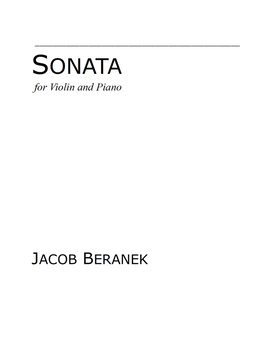SONATA FOR VIOLIN AND PIANO (2015)
violin, piano
violin, piano
|
Score & Part (digital download): $18.00
Score Only (digital download): $14.00 Score & Part (hard copy): $30.00 + shipping Score Only (hard copy): $22.00 + shipping |
PROGRAM NOTES
The Sonata for Violin and Piano combines several musical elements to form one, unified composition. It incorporates a variety of influences from different styles and origins, and derives inspiration from the works of many European composers of the 20th century. Given his strong Czech and German ancestry, the composer seeks to reflect his heritage while infusing modern twists into his music.
In the first movement, the most serious of the three, a quiet energy is constantly present, driving the music forward. Interplay between the two instruments is introduced, which becomes more prominent throughout the piece. The second movement begins in a somewhat bumbling manner, but excitement builds rapidly. Sections of playfully rhythmic themes are contrasted with more lyrical ones that create an enticing musical conversation. After the second movement’s triumphant conclusion, a dreamlike theme is introduced by the violin to commence the final movement. This theme serves as a jumping-off point for several variations that travel across the world and through the many emotions of the heart. The kaleidoscopic journey comes to an exuberant finale with strains of a boisterous Czech folk dance.
As a whole, the Sonata is anchored in contrasts between musical extremes: humor with melancholy, folk with classicism, pensiveness with excitement, and plaintive feeling with exultant praise.
—Jacob Beranek
The Sonata for Violin and Piano combines several musical elements to form one, unified composition. It incorporates a variety of influences from different styles and origins, and derives inspiration from the works of many European composers of the 20th century. Given his strong Czech and German ancestry, the composer seeks to reflect his heritage while infusing modern twists into his music.
In the first movement, the most serious of the three, a quiet energy is constantly present, driving the music forward. Interplay between the two instruments is introduced, which becomes more prominent throughout the piece. The second movement begins in a somewhat bumbling manner, but excitement builds rapidly. Sections of playfully rhythmic themes are contrasted with more lyrical ones that create an enticing musical conversation. After the second movement’s triumphant conclusion, a dreamlike theme is introduced by the violin to commence the final movement. This theme serves as a jumping-off point for several variations that travel across the world and through the many emotions of the heart. The kaleidoscopic journey comes to an exuberant finale with strains of a boisterous Czech folk dance.
As a whole, the Sonata is anchored in contrasts between musical extremes: humor with melancholy, folk with classicism, pensiveness with excitement, and plaintive feeling with exultant praise.
—Jacob Beranek


